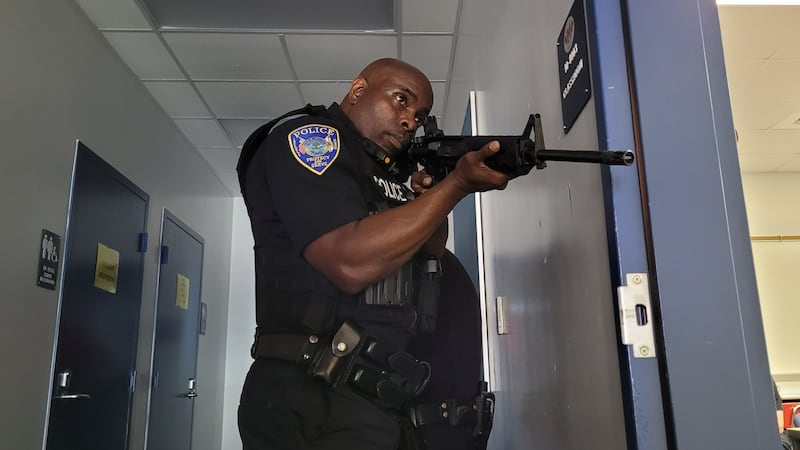What You Required to Know About Effective Active Shooter Training
What You Required to Know About Effective Active Shooter Training
Blog Article
Exploring the Key Components and Goals of Efficient Active Shooter Training Programs
Energetic shooter training programs are crucial in equipping people and organizations with the necessary skills to respond effectively to possible threats. As we discover the complexities of these training programs, it becomes obvious that understanding their comprehensive nature is important to improving safety actions and action capacities.
Relevance of Active Shooter Training
Energetic shooter training programs are vital for improving preparedness and feedback when faced with prospective risks. These programs intend to equip individuals, organizations, and communities with the expertise and abilities needed to effectively respond to energetic shooter situations. The boosting regularity and intensity of such cases highlight the relevance of aggressive measures, as prompt and informed reactions can substantially mitigate injury.

Additionally, these programs can help reduce the stress and anxiety and anxiety that usually go along with discussions about possible threats. By supplying structured support and useful strategies, people gain self-confidence in their capacity to respond properly. Inevitably, the importance of energetic shooter training lies in its possible to save lives, minimize injuries, and cultivate a prepared and resilient community efficient in dealing with unforeseen obstacles.
Secret Components of Training Programs
Reliable active shooter training programs commonly incorporate numerous key parts created to prepare individuals for real-world circumstances. The initial element is detailed education and learning on the nature of energetic shooter incidents, consisting of stats, instance research studies, and mental aspects that affect assailants. This academic structure is essential for fostering understanding and understanding amongst individuals.
Following, programs often include training on individual precaution, stressing the "Run, Hide, Battle" technique. Individuals learn exactly how to analyze their environment, make quick choices, and take ideal activities during a dilemma. Additionally, the inclusion of reliable interaction skills is important, as individuals need to understand how to report incidents and share essential details with police.
Another vital part is the participation of law enforcement or security specialists, that supply insights into tactical actions and the importance of cooperation during a dilemma. Programs should resolve the emotional results of an energetic shooter scenario, supplying approaches for coping and recuperation.
Lastly, ongoing training and correspondence course are essential to make sure that knowledge remains current and individuals feel great in their capabilities. Together, these essential components create a well-rounded training program that outfits people to react properly to an active shooter event.
Realistic Circumstance Simulations
Realistic scenario simulations are a critical element of energetic shooter training programs, offering participants with the possibility to participate in hands-on technique that mirrors possible real-life situations. These simulations enhance the training experience by developing an immersive environment where people can use theoretical knowledge in useful settings.
With the use of role-playing, mock scenarios, and specialized training centers, individuals experience the prompt difficulties and stressors connected with an energetic shooter case. This technique of training promotes quick decision-making, team effort, and the application of safety and security protocols under stress. It allows responders to establish important abilities such as situational recognition, threat evaluation, and efficient discharge treatments.
Moreover, practical simulations assist to recognize prospective weaknesses in participants' feedbacks, making it possible for trainers to supply targeted comments and improve general preparedness. The incorporation of varying circumstances, including different places and assaulter profiles, even more enhances the training experience, making certain that individuals are fully equipped to handle a series of prospective circumstances.
Inevitably, these simulations serve not only to instruct yet additionally to construct self-confidence amongst participants, fostering a feeling of preparedness that is important for reliable emergency situation reaction despite an energetic shooter danger. active shooter training.
Interaction Methods in Training
Clear communication is vital in energetic shooter training programs, click this as it directly affects the effectiveness of response efforts throughout a situation. Training individuals need to understand the procedures and procedures that will assist their actions if faced with an active shooter circumstance. Establishing clear lines of interaction ensures that all people involved can communicate information quickly and accurately.

In addition, training programs need to stress the relevance of energetic listening. Ultimately, effective interaction approaches are essential he has a good point for preparing individuals to respond emphatically and cohesively in the face of an energetic shooter event.
Mental Readiness Strategies
Emotional readiness methods are progressively recognized as vital elements of active shooter training programs. These techniques intend to equip individuals with the psychological strength essential to respond successfully in high-stress circumstances. By cultivating a frame of mind in harmony with possible threats, participants can better manage concern, anxiety, and complication throughout essential incidents.
Trick psychological readiness methods consist of scenario-based training and stress vaccination exercises. Scenario-based training submerses individuals in sensible simulations that mimic the disorder of an energetic shooter occasion, allowing them to practice decision-making under pressure. This direct exposure aids develop familiarity with emergency situation procedures, enhancing natural responses.
Tension shot includes gradual exposure to stress-inducing circumstances, permitting people to establish coping systems. This can include breathing exercises, visualization techniques, and cognitive restructuring to reframe negative ideas. By incorporating these strategies, training programs can cultivate a sense of confidence and control, which is crucial in crisis scenarios.
In addition, post-incident emotional support is important to deal with the emotional consequences of an active shooter occasion. Integrating mental health and wellness resources into training programs not only prepares individuals for immediate actions yet also promotes long-term mental wellness, eventually adding to a more secure and extra resistant setting.
Verdict

Report this page